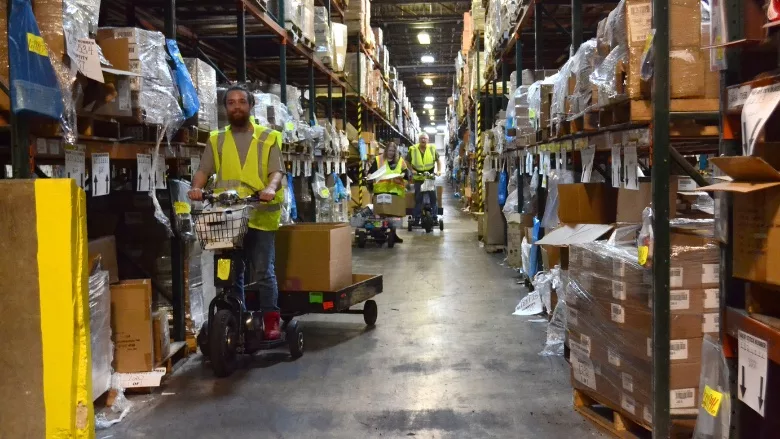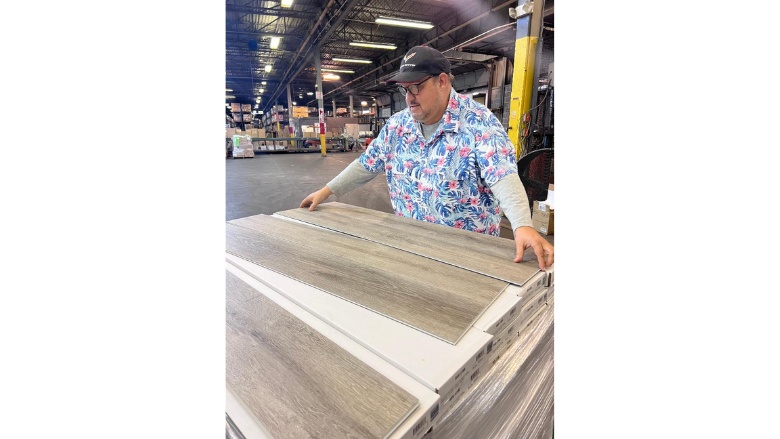How In-Kind Donations May Help Clear Your Excess Flooring Inventory Problem

The NAEIR warehouse is filled from top to bottom with gifts-in-kind donations. Photo: NAEIR.
Uncertainty is the theme for the fourth quarter for flooring businesses. Struggling to manage their inventory as delays and shortages continue in the supply chain, they have concerns that, by the time they do have inventory, the window will have closed for getting it sold.
The In-Kind Solution
Those pallets and shelves of excess and returned inventory are not going to empty themselves. They’re going to take up valuable storage space and potentially drag down profitability.
The good news is, there’s a smart, easy way to turn that burden into a hefty asset, while doing something positive for the community. It’s called product philanthropy. And for C Corporations, it’s one of the best kept secrets of the IRS tax code.
Current economic conditions are straining families’ budgets, and nonprofit organizations are being called on to do more with less.
To encourage American businesses to help their communities, IRS regulations allow Regular C Corporations to take an above-cost federal income tax deduction for in-kind donations. Companies not only donate to clear out warehouse space and avoid having to deal with liquidators, but also to ensure that their merchandise will be distributed to a closed market and to meet their philanthropic goals.
A gifts-in-kind organizations make it easy for companies to make these donations. When companies donate their stock to a gifts-in-kind organization, they don’t have to spend valuable staff time identifying deserving charities and working out logistics. Gifts-in-kind organizations are nonprofits that collect corporate product donations and then turn them over to qualified nonprofits. They accept 100 percent of overstocked items, whether it’s a truckload or a few cartons, and makes sure those items go to qualified 501(3)(c) nonprofits.
For example, the National Association for the Exchange of Industrial Resources (NAEIR) gives away $100 million a year to schools, churches and other nonprofits, enabling them to stretch their budgets in an era of soaring inflation. Since its founding, NAEIR has received donations from more than 8,000 U.S. corporations and distributed more than $3 billion in products.
A reputable in-kind donation operation will not only give you a full accounting of how your donation was used; it will ensure that a client’s flooring product doesn’t end up on the open market where its brand can be diluted. Or in a landfill.
 Wisenbaker Builder Services (WBS) has donated a great deal of SPC wood flooring to NAEIR over the years, "They have always been a great company to work with," said Terry Livingston, sales director. Photo: NAEIR.
Wisenbaker Builder Services (WBS) has donated a great deal of SPC wood flooring to NAEIR over the years, "They have always been a great company to work with," said Terry Livingston, sales director. Photo: NAEIR.
All That and a Tax Deduction, Too
In these challenging times, an in-kind donation may be a welcome benefit to the bottom line. Section 170(e)(3) of the Internal Revenue Code states that when Regular C corporations donate inventory to qualified nonprofits, they can receive a tax deduction equal to up to twice the cost of the donated products.
Under the tax code, deductions are equal to the cost of the inventory donated, plus half the difference between the cost and fair market-selling price, not to exceed twice the cost.
For example, if a product costs $10 and retails for $30, the difference is $20. Half of $20 is $10. So, $10 (product cost) plus $10 (half the difference) equals a $20 deduction. As $20 does not exceed twice the product cost, it is an allowable deduction. It’s that simple.
It’s truly a win-win. Best of all, a company has the satisfaction of knowing it has helped a school or nonprofit better serve its students and clients. In addition, the positive PR generated by such generosity burnishes a company’s reputation.
Looking Ahead to 2024
Matching supply and demand is like balancing on the head of a pin. Lean one way and a flooring business owner can’t keep up with customer demand. Lean the other way and they have more inventory than they know what to do with.
Merchandisers will continue to move away from “just-in-time” stocking strategies to create inventory buffers. But world events, changes in seasonality, shifts in consumer preference, more frequent intense weather events, inflation and dozens other unpredictable factors can completely throw inventory forecasts out the window.
There’s no one solution to inventory woes. An in-kind donation, though, can help them clear inventory, do good for their community and achieve a significant tax break.
For more product donation news, click here.
Looking for a reprint of this article?
From high-res PDFs to custom plaques, order your copy today!
.webp?height=200&t=1692362011&width=200)




